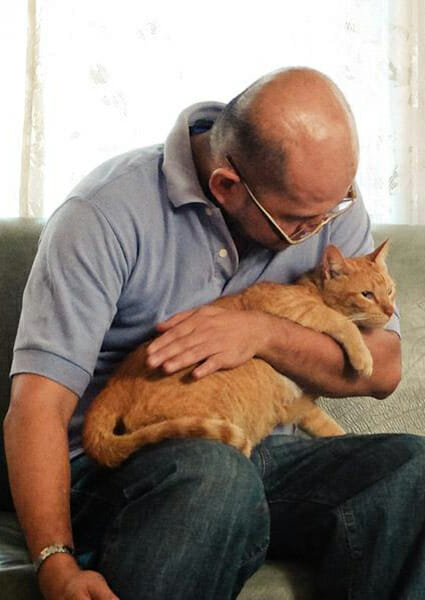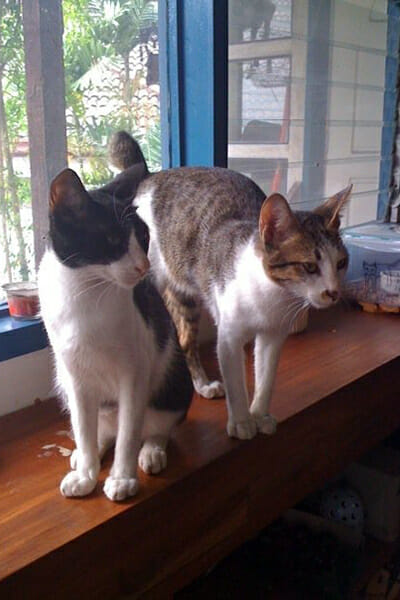Painter, children’s book illustrator, and Visual Arts teacher Ouie Badelles has been fostering cats since 2008. The 54-year-old artist has fostered over 10 cats to date, saying, “I take kittens mostly, because they are easy to pick up from the street. They are easier to handle than bigger cats.”
Ouie opened up to Waldo’s Friends about temporarily welcoming cats into his feline-dominated flat (he owns three full-grown cats) and finding them furever homes.
Help out by donating to Philippine Animal Welfare Society (PAWS)
With your kind assistance, PAWS can care for over 500 cats and dogs rescued from cruelty or neglect.
Waldo’s Friends (WF): How did you get into fostering?

Photo and cover image by Sheila Catilo
Ouie Badelles (OB): My first fosters were two male kittens I found on the street, outside my previous home. Back then, my only pet was a half-blind pug named Stitch, who I adopted after he was abandoned. I was driving toward the compound gate and saw a carton box by the road with two kittens inside it. I silently muttered, “No. No. No… Don’t look at me.” But one looked at me while I was driving by and followed the car. I had to stop.
I have to mention that earlier that afternoon, I had just witnessed a kitten being run over. After a car’s tyre rolled over the kitten, it still tried to get up and was run over again. I was in tears as I drove away. The image was still vivid in my head, so I was carrying this feeling when I saw the two kittens.
I decided to take the kittens home to stay with me overnight, then bring them to the shelter the next day. However, the shelter was full, so they encouraged me to foster. They gave me a week’s supply of kitten formula and a medicine dropper to feed the kittens.
The two kittens stayed with me for around three months until I found a home for them. When I brought them to their new home, I gave a starter care package of cat food, a bag of kitty litter, and a litter box. I was in tears when their new daddy was carrying them into their new home. Ten years later, they are happy and in good health, as their daddy updates me every now and then.
WF: How did Stitch initially feel about the two kittens being around? How did you help him adjust to them?
OB: Stitch, by nature, was a pacifist, and had no aggression. He was a Dr. Dog for PAWS. He welcomed everyone, human or animal. Sometimes, he would bark at the cats or kittens if they were running around. When he was younger, he would even run and play with them.

WF: Are you involved with any of the animal rescues in your community or do you foster on your own?
OB: I foster on my own. My most recent one was a kitten rescued from the highway who was about to be run over. He stayed with me for a month. He is now with someone I used to work with. I would rather rehome my fosters with someone I know or someone I can check up on once in a while.
WF: Do you remember the most number of fosters you’ve taken in at one time? What was this experience like?
OB: I think the most I had was seven cats but they were of different ages. One time, I arrived home and they were all at my dinner table looking at me, waiting for me to feed them. Back then at my old place (which had a big yard), I would just leave the door open so the cats could come in and out and keep Stitch company.

WF: What do you love most about fostering kittens?
OB: Among so many things that fostering has given me, I think what I love most about it is seeing how an animal moves from innocence to trust, or (in the case of my formerly feral fosters) from distrust toward a human to a regard of full trust and fondness.
My best example for the latter would be Almond, a foster fail from The Peninsula Manila Hotel. He used to be feral and ferocious. During our first few days together after he was neutered, I kept him in a cage. Whenever I needed to insert my hand into his cage to feed him or change his water, I had to wear a thick glove because he hissed, clawed, or bit me. It was really an uncomfortable experience for both of us.
One morning, he made a show of not liking me while I was opening his cage, so I snapped at him and said, “Ay, bahala ka sa buhay mo!” [“It’s your life, do what you want!”] I did not feed him that day. The next day, he seemed to have reached the realisation that I am the one taking care of him and that I will not hurt him. He began to purr and I fed him without issue. The following day, the glove was no longer necessary.
I took care of Almond for 10 years. I considered adopting him out several times, but he showed that he trusts nobody else but me. Whenever family or visitors came over, he would hide. He never let anyone else come close to him and touch him. As he got older, he would sleep beside my feet and nuzzle my toes while purring.


WF: What are the challenges that come with fostering?
OB: Finding the right paw-rents is always challenging. Some are not aware that certain coat colours and patterns have temperaments. For instance, tabbies tend to be even-tempered and more cuddly, while blacks are very welcoming and love nuzzling your legs. They do not like to be picked up and carried for more than a minute, and yet they are very protective of their furry and human families. Meanwhile, calicos are very choosy with their humans but love tummy cuddles. People who are not aware of these coat and personality affinities tend to choose the “prettier” cats.
Another challenge is that cats are more attached to places than to people. So a new rehoming would involve the cat needing to stay indoors for at least a week to feel comfortable with the place, otherwise they will find their way back to their former home. It has happened to me! One time, I transferred residences and one of my fosters ran away. I did not see him for a month. When he finally showed up, he was thin and hungry. While I was feeding him, he was meowing in between chews, as if saying, “I am so sorry I ran away. I am not going to do that again.”
WF: Can you share some of your funniest or most interesting foster stories to date?
OB: One foster was out of sight yet inside his new home for a full week. The family’s only indications that he was present was that his food and water were being consumed and his litter box was being used. During his second week, he kept his distance from them and would hide again if approached. Good thing I oriented his family that this was normal as they built trust. The best thing to do during that transition would be to respect his distance and wait for his proximity bubble to decrease. They would ignore him by not looking at him, but they would speak to him so he would get used to their voices and presence. After a month, he was already taking naps on their laps.
Another foster of mine was lucky to have been the only cat I was fostering after I picked him up from a busy city street. Since he had no elder cats to teach him how to behave, he regarded Stitch as his parent. He learned the ways of a pug: he greeted me when I got home, walked with me from the car to the front door, and snuggled with me the way Stitch would. Also, he would jump up at me and cling onto my t-shirts with his claws. He did not realise his claws hurt until I fostered another kitten. During their plays, he learned that cat claws could draw blood! He retracted his claws and no longer jumped up to greet me.
This foster cat then passed on the same things Stitch taught him to the new fosters. He was around four years old when I found a home for him and another cat. The new family found it so endearing that the two of them behaved like dogs: greeting them when they got home, and walking with them from the car to the front door.
WF: When it’s time to give away your foster, how easy or difficult is it for you?
OB: It is always an emotional time. As much as possible, I prefer to bring them to their new home so I can see the household set-up. I recommend where to place the litter box and feeding area, and to orient them about the need for a scratching post, especially if it will be their first cat and their home has antique furniture or leather sofas. I also prepare a care package consisting of a week’s supply of cat food, a toy, and a bag of kitty litter.
WF: Aside from fostering, you have three cats of your own. How do they feel about you bringing in other animals temporarily?
OB: There is always an awkward period of a few days. There is initially a lot of hissing and snarling, but once they get used to each other’s scents, they are okay.

WF: How has your life changed after fostering animals?
OB: I learned to be more patient and sensitive to the fact that animals (and humans) each have their own baggage as they find a place where they can be themselves and be safe.
WF: What’s the best tip you can give for first-time parents?
OB: For first-time foster parents, I suggest that they anticipate every need of their ward. Start with the basic needs (food, safe shelter, designated place to pee and poop) and then move on to the next level, the need to adjust socially within their family. Anticipate that fosters do not know how to behave with a human family or with other animals, and they need to learn how to behave appropriately so that they will emerge as well-adjusted and more likely to find their new homes.
Another is to prepare to have your heart broken on your first rehoming. Keep in mind that once you have rehomed a foster, you have just cleared the space in your home and heart for another younger animal who needs a safe place.
WF: Why would you personally encourage people to foster animals?
OB: It builds character, both for you and your foster. I see fostering as one way to build a community of caring individuals and families who are willing to take care of others in need (human or animal). If we have caring communities, it is one significant step closer to what we want: world peace.
Follow the adventures of Ouie and his foster kittens on Instagram.
Read more rescue stories here! Do you know of an interesting pet adoption, foster, or rescue story? Share your suggestion with us by commenting below!
Leave a comment
Your email address will not be published. All fields are required.